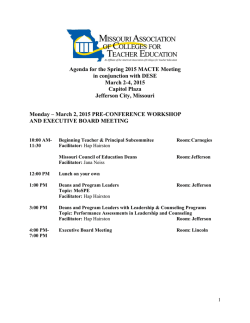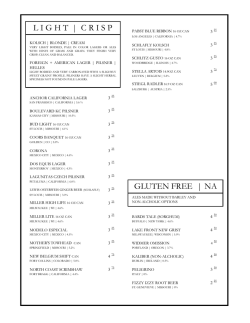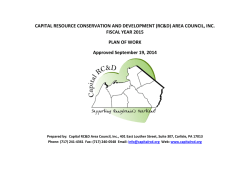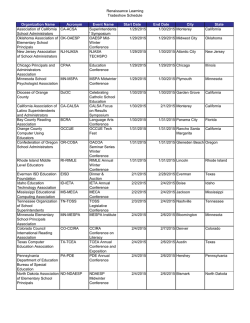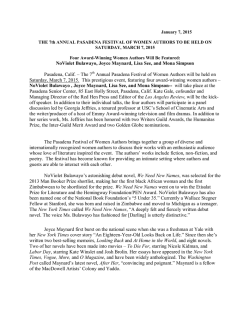
here - Missouri Natural Resources Conference
Values of Conservation Fostering natural resources appreciation through research, management and outreach. February 4-6, 2015 Tan-Tar-A Resort Osage Beach, Missouri Values of Conservation Fostering natural resources appreciation through research, management and outreach. Feb. 4-6, 2015 The Missouri Natural Resources Conference (MNRC) is an annual meeting organized and sponsored by the Missouri Chapter of the American Fisheries Society, the Missouri Chapter of the Society of American Foresters, the Missouri Chapter of The Wildlife Society, and the Show-Me Chapter of the Soil and Water Conservation Society. This unique blend of disciplines, represented by the four societies, promotes wise use and management of Missouri’s natural resources. Each year the conference hosts about 800 people working in the natural resources field who meet to exchange information and ideas and encourage continued cooperation among resource professionals, agencies, and other natural resource stakeholders. Cooperating agencies are the Missouri Department of Conservation, University of Missouri, School of Natural Resources, the Missouri Cooperative Fish and Wildlife Research Unit; U.S. Fish and Wildlife Service, the U.S. Forest Service and the Natural Resources Conservation Service. 2 Welcome 4 Events-at-a-Glance 5 Plenary Speakers 10 Workshop Matrix 12 Tan-Tar-A Room Location Map 13 Student Job Fair 14 Affiliated Meetings 16 Workshop Descriptions 18 Contributed Papers 32 Posters 36 Sponsors 44 Exhibitors 46 Sponsoring Societies 49 Planning Committee 51 Sponsoring Societies: Missouri Chapter of the American Fisheries Society Missouri Chapter of The Wildlife Society Missouri Society of American Foresters Show-Me Chapter - Soil and Water Conservation Society In Cooperation With: Missouri Department of Conservation (MDC) University of Missouri, School of Natural Resources Missouri Cooperative Fish and Wildlife Research Unit; U.S. Fish and Wildlife Service (USFWS) U.S. Forest Service (USFS) Natural Resources Conservation Service (NRCS) 3 Table of Contents Table of Contents Welcome to the 2015 Missouri Natural Resources Conference As chairman of the 2015 Missouri Natural Resources Conference (MNRC), I would like to welcome you. We have great events planned that will provide you with a myriad of professional development and networking opportunities. We also have special events planned for students, so if this is your first time attending this conference or if you’ve attended for the last 20 years, there is something here for you. The 2015 MNRC Steering Committee has worked hard to develop a conference that is packed with information and inspiration to help you learn about Missouri’s natural resources no matter where you are in your career. This year’s theme, “Values of Conservation…. Fostering Natural Resources Appreciation Through Research, Management, and Outreach,” is very timely, as our lives are increasingly dominated by electronics, and young people seem more interested in video games and texting than seeing the sun rise over an Ozark stream or an eagle soaring overhead. As professionals, we are challenged with developing new ways to inspire citizens, especially young people, to unplug and appreciate Missouri’s amazing natural resources. We need people of all ages to appreciate nature if we want their support in protecting and enhancing Missouri’s natural resources. We have two excellent plenary speakers who will give us some things to think about as we strive to meet the challenges we face as natural resource professionals. I hope you leave this conference with new ideas and tools to use to engage others and develop and strengthen their appreciation for nature. The entire 2015 MNRC Steering Committee welcomes you and thanks you for attending this year’s conference! Alan Leary 2015 MNRC Steering Committee Chairman 4 2015 MNRC Events-at-a-Glance Affiliated Meetings Numerous meetings, conferences, and luncheons are scheduled during the week. See “Affiliated Meetings” on pages 16-17 for specific meeting times and locations. Check inhouse monitors for schedule updates and room changes. 1—9 pm Registration (Grand Ballroom Foyer) 1 – 9 pm Exhibits (Windgate Hall) 3 – 4 pm Career Possibilities, Qualifications, and Interviewing (Parasol II) 4:15 – 5:15 pm Speed Networking with Resource Professionals (Parasol II) 5:15 – 6:30 pm Student Job Fair (Parasol I) Resume Review (Parasol II) 6:30—9 pm Washer Madness (Windgate Hall) Play washers for a chance to win a Remington 870 Express 12 gauge shotgun or a Bass Pro Shops gift card 6:30 – 11 pm Mixer and Poster Session Windgate Hall) Food and beverages with paid registration (name tags required). Exhibitors. Authors of posters will be available for questions from 7 – 9 pm. Raffles and silent auctions. 5 Events-at-a-Glance Wednesday, Feb. 4 Thursday, Feb. 5 6:30 – 8 am Prayer Breakfast (Parasol II) 7 am – 3:30 pm Registration (Grand Ballroom Foyer) 7 – 8:20 am Continental Breakfast (Windgate Hall) Free to all registered attendees 9 – 9:05 am Welcome to the 2015 MNRC (Salons A & B) 9:05 – 10:05 am Plenary Session (Salons A & B) Conserving Nature by Conserving Food-webs Dr. Doug Tallamy Professor and Chair of Entomology & Wildlife Ecology University of Delaware 10:05 – 10:25 am Break (Windgate – Cookies and Beverages) 10:30 – 11:30 am Plenary Session (Salons A & B) 9 Billion Reasons Dave White Principal and Founder, 9b Group, Former Chief, NRCS 12 – 1 pm Lunch on Your Own (Italian buffet lunch in Windgate Hall) Prepaid, cash, or credit card; may NOT charge to room. Cost $14 if not prepaid. 1 – 3 pm Workshops (see pages 18-20 for descriptions) Celebrating 35 Years of the Missouri Natural Heritage Program (Salon A) How Successful Partnerships Deliver Significant Benefits (Salon B) Stream Restoration and Enhancement (Salon C) 6 Thursday, Feb. 5 (cont.) 1—3 pm Contributed Papers Water Quality/Hydrology/Soils (Room 60/61) Forestry (Room 62/64) Fisheries/Aquatic Species (Parasol II) Wildlife (Parasol I) 3 – 3:30 pm Break (Windgate Hall) Exhibits and posters will remain on display until 6 pm. Society raffles and silent auctions may close at this time. 3 – 6 pm Society Chapter Meetings Missouri Chapter of The Wildlife Society (Salon A) Missouri Chapter of American Fisheries Society (Salon B) Show-Me Chapter, Soil & Water Conservation Society (Rm 60/61) Missouri Society of American Foresters (Rm 62/63/64) *Individual times for each meeting are listed on pages 16-17. 6 – 7 pm Dinner (on your own) Thursday, Feb. 5, Evening Events Award Ceremony and Dessert Buffet (Salon C) Free to all registered attendees with a name tag Cash Bar 7:15 – 10:30 pm Social Hour 7:30 – 8:30 pm Dessert Buffet 7:45 – 9:45 pm Welcome 8:30 – 8:40 pm ...With a word from the Conservation Federation President Awards 8:40 – 9:40 pm Raffle Drawings 9:40 – 10:00 pm 7 Friday, Feb. 6 7—8 am Continental Breakfast (Windgate Hall) Free to all registered attendees 7 – 10 am Registration (Grand Ballroom Foyer) 8 – 10 am Workshops (see pages 21-27 for descriptions) Grazing Makes it Better (Salon A) Endangered, Threatened, and Imperiled Species (Salon B) Ecological Sites for Conservation Planning and Land Management in Missouri (Salon C) The Missouri Model of Resource Law Enforcement Continued (Room 60/61) Big River Task Force: Interagency Cooperation for Remediation, Restoration, and Outreach (Room 62/64) Hydrilla – Taming the New Missouri Monster (Parasol II) MDC Active Shooter Training (Parasol I) 10 – 10:15 am Break 8 Friday, Feb. 6 (cont.) 10:15 am – 12:15 pm Workshops (see pages 27-29 for descriptions) Cover Crops (Salon A) How to Involve Volunteers in Priority Geographies (Salon B) Ecological Sites for Conservation Planning and Land Management in Missouri (Salon C) Diversity in Conservation (Room 60/61) Big River Task Force: Interagency Cooperation for Remediation, Restoration, and Outreach (Room 62/64) Addressing Invasive Species in Missouri (Parasol II) 12 – 1 pm Quad Societies Presidents’ Luncheons (Room 74/75) 9 Dr. Doug Tallamy “Conserving Nature by Conserving Food-webs” Doug Tallamy is a professor in the Department of Entomology and Wildlife Ecology at the University of Delaware where he has authored 80 research articles and has taught Insect Taxonomy, Behavioral Ecology, Humans and Nature, Insect Ecology and other courses for 32 years. Chief among his research goals is to better understand the many ways insects interact with plants and how such interactions determine the diversity of animal communities. His book “Bringing Nature Home; How Native Plants Sustain Wildlife in Our Gardens” was published by Timber Press in 2007 and was awarded the 2008 silver medal by the Garden Writer’s Association. "The Living Landscape" coauthored with Rick Darke, was published in 2014. Doug was awarded the Garden Club of America Margaret Douglas Medal for Conservation and the Tom Dodd Jr. Award of Excellence in 2013. 10 Dave White “Nine Billion Reasons” 11 Plenary Session Dave White has over 35 years of leadership experience in conservation with the Natural Resources Conservation Service (NRCS) and in the private sector. After working in numerous locations throughout the U.S., Dave was Chief of the NRCS from Jan. 2009 to Dec. 2012. As Chief, he directed and managed the nation’s largest private lands natural resource conservation organization. Today, as a consultant and president of a small start-up company, Dave brings his expertise to sustainability efforts, establishing water quality trading, and promoting effective policies that advance conservation on private lands. He has extensive experience in overseeing complex resource protection programs, working with diverse interests, developing and moving conservation legislation, and providing leadership for the successful implementation of natural resource goals. While at NRCS, he developed and implemented conservation solutions with private landowners, primarily agriculture, working in cooperation with a wide diversity of partners. Under his leadership, the NRCS created and implemented landscape-level conservation initiatives focusing financial and technical resources on solving problems at appropriate ecological scales. Dave has spent significant time on Capitol Hill. In 2007, he was detailed to Iowa Senator Tom Harkin’s office in Washington, D.C., where he helped craft the conservation title of the 2008 Farm Bill. He also served on a detail to Indiana Senator Richard Lugar and helped develop the conservation title of the 2002 Farm Bill. Dave is an honors graduate of the University of Missouri where he studied agricultural journalism. He and his wife live in Charlottesville, Virginia. Salon B Cover Crops Friday 8 – 10 am Friday 10:15 am – 12:15 pm Missouri Natural Heritage Program Volunteers and Priority Geographies Endangered, Threatened, and Imperiled Species Successful Partnerships / Significant Benefits Plenary Speakers Salon A Grazing Makes it Better Thursday 1 – 3 pm Thursday 9 – 11:30 am Date Ecological Sites for Conservation Planning and Land Management in Missouri Stream Restoration and Enhancement Salon C Conference Map & Workshop Matrix 12 Diversity in Conservation The Missouri Model of Resource Law Enforcement Continued Water Quality/ Hydrology/Soils Contributed Papers Room 60/61 Big River Task Force: Interagency Cooperation for Remediation, Restoration, and Outreach Forestry Contributed Papers Room 62/64 Addressing Invasive Species Hydrilla – Taming the New Missouri Monster Fisheries/ Aquatic Contributed Papers Parasol II MDC Active Shooter Training Wildlife Contributed Papers Parasol I 13 2015 MNRC Student Job Fair Are you a Natural Resources student looking for a resource-related job? Maybe you are a resource professional, university professor, or graduate student looking for qualified help. The four society conference sponsors are trying to bring students and employers together. We are hosting the 18th Annual Student Job Fair at the 2015 Missouri Natural Resources Conference on Wednesday, February 4th, 2015 in Parasol I & II at the Tan-Tar-A Resort in Osage Beach. Individual interaction with employers will provide information to students about hiring trends in the Forestry, Fisheries, and Wildlife disciplines. Don’t miss this opportunity to learn about the latest information on gaining employment in the natural resources field. The Job Fair will begin at 5:15 pm and will conclude at the start of the Conference Mixer at 6:30 pm. Representatives from several resource agencies, not-for-profit organizations, and businesses who have jobs currently open will be present. Again, this year we will conduct a “Speed Networking” session in Parasol II from 4:15 to 5:15 pm. We will also continue the popular resume critique booth so that participants can have their resumes polished up by resource professionals. Information on specific jobs will be available, as in past years. All you have to do is show up at Tan-Tar-A. No registration is required and you do not have to attend the conference to attend the Job Fair. It is suggested that you bring copies of your resume for the resume review booth and also to hand out. This year we will also conduct a “Career Possibilities, Qualifications and Interviewing” session from 3:00 to 4:00 pm and a “Speed Networking” session in Parasol II from 4:15 to 5:15 pm. We will also continue the popular resume critique booth so that participants can have their resumes polished up by resource professionals. Information on specific jobs will be available, as in past years. Student Job Fair Shane Kampeter Missouri Army National Guard Conservation Section Chief 14 Job Fair Notes Student Job Fair 15 16 Kim Worth John Tuttle Mike Leahy Martha TomlinMcCrary SWCS-Executive Board Meeting MoSAF-Executive Board Meeting MDC-Natural History Biologist Electronic Device Training for Creel Survey Megan Halford MDC-Angler Recruitment Scott Sudkamp Donna Baldwin/ Justine Gartner Forestry Division Awards Lunch Small Game and Grasslands Management Workshop Donna Baldwin/ Justine Gartner Forestry Division Leadership Team Meeting Vince Travnicheck Alan Leary MNRC Pre Conference Committee Meeting MoAFS Fisheries Symposium Contact Meeting Affiliated Meetings Feb. 4 Feb. 4 Feb. 4 Feb. 4 Feb. 4 Feb. 4 Feb. 4 Feb. 4 Feb. 4 Feb. 4 Date 2—4 pm 2—5 pm 2—5 pm 2—4:30 pm 1—5 pm 9 am—4:30 pm 10:30 am—2 pm 12—1:30 pm 8:30 am—5 pm 9—10 am Time Redbud Rm 61 74/75 76/77 Salon B Salon A 64 Parasol I 62/63 Parasol II Room 17 Megan Halford Ted Seiler Janice Greene Justin Focht or Kathi Moore Merv Wallace John Tuttle Kim Worth Ted Seiler Mike Smith Ted Seiler Alan Leary MDC-National Forest Service MoTWS Executive Board Meeting MSU Alumni Breakfast Prayer Breakfast MO Native Seed Association MoSAF—Business Meeting Show-Me SWCS—Business Meeting MoTWS—Business Meeting MoAFS—Business Meeting Quad Society Meeting MNRC Post Conference Meeting Feb. 6 Feb. 6 Feb. 5 Feb. 5 Feb. 5 Feb. 5 Feb. 5 Feb. 5 Feb. 5 Feb. 4 Feb. 4 1—3 pm 12—1 pm 3:30 —5:30 pm 3— 6 pm 3:30—5:30 pm 3—5 pm 2—5 pm 6:30 —8 am 7—8 am 3—5 pm 3 —5 pm Parasol I 74/75 Salon B Salon A 60/61 62/63/64 76/77 Parasol II Parasol I 60 64 2015 MNRC Workshops Thursday, Feb. 5 1-3 p.m. Celebrating 35 Years of the Missouri Natural Heritage Program (Salon A) Moderator: Malissa Underwood (MDC) The Missouri Natural Heritage Program (NHP) has a long history in fostering appreciation of natural resources through research, management, and conservation. It is a contributing partner with nearly 80 other NHPs throughout the Western Hemisphere, including the U.S., Canada, Latin America, and South America. Missouri’s NHP currently tracks over 30,000 occurrences of species and natural communities of conservation concern and receives over 5,000 requests for information every year. Data is shared with 34 partners, including federal, state, and local agencies and organizations along with private consultants in mitigating impacts and enhancing conservation efforts for rare species. The number of element occurrences in the Natural Heritage Database grows by approximately 1,000 records annually and the number of datasharing partners and requests for information also continues to grow every year. As the 35th anniversary of the Missouri NHP approaches, this session will provide a look back at how the program began and its value to the conservation of rare species, as well as a look ahead to the future directions of the program. This workshop will include initial pioneers that were involved in developing the NHP in Missouri, current staff within the Missouri NHP, and users of the Natural Heritage Database that will share insights on the value of data sharing. Finally, this workshop will discuss how the program is an essential component in future projects. How Successful Partnerships Deliver Significant Benefits (Salon B) Moderator: Elsa Gallagher (Quail Forever) More habitat, more wildlife, more partnerships, more pollinators, more conservationists, more hunters. Good partnerships make participating organizations stronger. They are a formal link between professional networks and often result in expanded social networks. They give us access to skills that we may not possess, landowners we may not be in 18 touch with, and resources we may not have. They challenge us to meet the goals of others for the benefit of all. With partnerships we can do more with less and accomplish more than we ever could have alone. Working Where the Circles Meet Elsa Gallagher (Quail Forever) Bringing it All Together for a Quality Landowner Experience and More Habitat Casey Bergthold and Ryan Diener (Quail Forever) Creating a Culture of Youth Involvement to Further our Outdoor Heritage and Habitat Mission Drew Larsen (Pheasants Forever and Quail Forever) and Ray Wright (University of Missouri, Bradford Research Farm) Nothing Changes until it Changes in the Dirt: Partnering to Improve Habitat through Pollinators and Improved Seed Mixes Pete Berthelsen (Pheasants Forever and Quail Forever) Stream Restoration and Enhancement (Salon C) Moderator: Steve Herrington Shoal Creek Woodlands for Wildlife: A Partnership in Action Rob Pulliam (Missouri Department of Conservation) 19 Thursday Workshops Stream restoration and enhancement practices are increasingly used to improve or restore the health and function of streams and rivers degraded due to urbanization, agricultural practices, and other land uses. These efforts encompass a wide-range of objectives, including stream bank stabilization, sediment and nutrient reduction, and recovery of aquatic species, and are comprised of a growing number of techniques that represent a shift from traditional hard-engineering towards function-based approaches. The goal of this workshop is to share information about current techniques, innovations, and applications of stream restoration and enhancement in Missouri and nationwide. Hatchery Creek Stream Restoration Project ‐ A unique opportunity to maximize trout habitat, create recreational opportunities, and provide mitigation credits George Athanasakes (Stantec) Understanding habitat dynamics to inform restoration of a large regulated river: the Lower Missouri River Susannah Erwin (U.S. Geological Survey) A unique landscape‐level approach using stream restoration for the recovery of the federally protected Okaloosa darter Christopher Metcalf (Coastal Hydrology) Implementing river restoration projects to reduce sediment and phosphorus loadings to Ozark mountain streams Matt Van Eps (Watershed Conservation Resource Center) Approaches to stream restoration and aquatic organism passage projects by the U.S. Forest Service Kelly Whitsett (U.S Forest Service) 20 Friday, Feb. 6 8 – 10 am (Salon A) Grazing Makes it Better Moderator: Elizabeth Hamilton-Steele Grazing native plants creates excellent quail habitat as well as habitat for many other species of wildlife and pollinators. At the same time, grazing natives promotes soil health, which also has the potential to increase infiltration and decrease water runoff following precipitation. Native plants are adapted to grazing; historically many different herbivores, including bison and elk, grazed the grasslands. For the rancher, grazing diverse plantings of natives has many benefits, including the lack of toxic endophyte, good gains on livestock, 238% more forage production, and good flexibility on grazing periods. However, not all grazing has the same effects. By observing wild herbivores on grasslands, much has been learned about the principals that characterize good grazing. Grazing diverse natives, if done well, has the potential to benefit wildlife, ranchers, and the environment. Potential Impacts of Grazing on Bobwhite Quail Reproduction: Preliminary Results from the Southwest Missouri Quail Project Frank Loncarich and Kyle Hedges (Missouri Department of Conservation) Native Plants + Diversity = Good Soil Health Doug Peterson (NRCS) Grazing Diverse Natives: As Good as it Gets for the Rancher Amy Hamilton (Hamilton Native Outpost) Is Good Grazing an Oxymoron? If Not, “Show Me” Elizabeth Hamilton-Steele (Hamilton Native Outpost) 21 Friday Workshops 2015 MNRC Workshops Endangered, Threatened, and Imperiled Species (Salon B) Moderator: Paul McKenzie Imperiled Native Crayfish in Missouri - Reasons for Decline and Possible Listing Under the ESA Jacob Westhoff (University of Missouri) Recovering Missouri’s Federally Listed bats Shauna Marquardt (U.S. Fish and Wildlife Service) Using Artificial Propagation to Facilitate Recovery of the Topeka Shiner in Missouri Tom Foster (MDC) Survival of Released Juvenile Pink Mucket Pearly Mussels in the Lower Osage River Andy Roberts (U.S. Fish and Wildlife Service) Success of Reintroductions of American Burying Beetle in Missouri Bob Merz (St. Louis Zoo) Ecological Sites for Conservation Planning and Land Management in Missouri (Salon C) Moderator: Fred Young 8:00 am – 12:15 pm (field trip: 10:15 am – 12:15 pm) Missouri now has a complete set of Ecological Sites, covering every acre of the state. Although still in the “provisional” stage of development, the Ecological Site Descriptions (ESDs) contain sufficient information for use in conservation planning with landowners, land management of Conservation Areas, State Parks, and more. This two-part seminar is designed to acquaint participants with the practical applications of ESDs in Missouri. Ecological Sites: What They Are and Where They Came From Alicia Struckhoff (Missouri Department of Conservation) 22 The basic concepts behind Ecological Sites will be discussed, along with the structure of the Ecological Site system in Missouri, how Ecological Sites have been developed, and a brief overview of Ecological Site Descriptions. Information will be provided on how to access Ecological Site Descriptions. What do They Look Like? Four “Typical Missouri” Ecological Sites Tim Nigh (Missouri Department of Conservation – Retired) Four extensive Missouri Ecological Sites will be discussed as a way of familiarizing participants with Ecological Sites and the information included in Ecological Site Descriptions (ESDs) Using Ecological Sites with Landowners: Conservation Planning and Farm Bill Program Applications Doug Wallace (NRCS – Retired) Applications of Ecological Sites to conservation planning on private lands will be discussed, including implications for Farm Bill programs such as the Environmental Quality Incentives Program (EQIP) Managing Conservation Areas using Ecological Sites Jason Villwock (Missouri Department of Conservation) Applications of ecological sites to the management of Conservation Areas and other public lands will be discussed. Examples will illustrate how ESDs can be used along with field surveys to assess current site conditions and efficiently plan management activities. Natural Areas and Ecological Sites Mike Leahy (Missouri Department of Conservation) The Natural Area system in Missouri preserves a variety of “reference” plant communities that are associated with various ecological sites. The usefulness of the Natural Area system for ecological site development is discussed, along with the application of Ecological Site Descriptions (ESDs) to understanding and appreciating Natural Areas. Field Trip (Weather Permitting) – Lake of the Ozarks State Park Tim Nigh and Dennis Meinert (Missouri Department of Natural Resources) Participants will convene in the Grand Glaize Beach picnic area parking lot of Lake of the Ozarks State Park and walk out Rocky Top Trail. Tour will 23 proceed up the trail no later than 10:30 am. Field Trip instructions for participants: Be prepared for wet, cold field conditions. We will cancel only if the State Park road is impassable, if there is driving rain, or if the trail is excessively icy. Provide your own transportation to the trailhead. The parking area is about 10 minutes from Tan-Tar-A. Maps will be provided at the end of the morning presentations. Carpool if possible; arrange for a ride at the end of the morning presentations (moderator will facilitate this). Trip will disband at 12:00 pm, in the field. An optional one-hour extension (weather permitting) will examine several additional Ecological Sites farther along the trail system. Foul Weather Alternative – Salon C Participants will be informed at the end of the morning sessions if the field trip is cancelled. Small Group Exercise Participants will divide into small groups and work on a management plan for the field trip area (Rocky Top Trail) based on Ecological Sites The Missouri Model of Resource Law Enforcement (Room 60/61) Moderator: Randy Doman Discover Nature Girls Camp Program Conservation Agents Becky Robertson and Marsha Jones (MDC) The Discover Nature Girls Camp is a three-day, two-night summer camp that introduces girls from ages 11-15 to a variety of outdoor skills. Protection Division staff started this program in 2008 in the Northeast Region and it will have expanded to all eight regions in 2015. Participants take a hands-on, in-depth hunter education course that involves activities such as shooting, climbing a tree stand, and wildlife identification. At the end of the week, the girls take the hunter education exam and become hunter education certified. In addition, they spend the week actively participating in outdoor skills, including fishing, canoeing, archery, and Dutch oven cooking. To date, the program has introduced over 500 girls to a variety of 24 outdoor skills in a supportive, hands-on learning environment with their peers. Swift Water Rescue Program Conservation Agent Aaron Post (MDC) Missouri Department of Conservation Agents are increasingly called upon to assist in flooding events throughout the state and often find themselves involved in swift water rescues. The Department provides specialized training for agents to help ensure safe outcomes for all parties involved. This program will highlight the historical flooding events agents have responded to and the training and equipment used by Conservation Agents to rescue persons trapped by rising floodwaters. Telecheck Investigations Conservation Agents Chris Doran and Andrew Mothershead (MDC) Since the Missouri Department of Conservation transitioned from the check stations to the Telecheck harvest reporting system, Conservation Agents have adapted their deer and turkey enforcement techniques accordingly. This program will highlight methods Conservation Agents use to determine the level of compliance with the automated harvest reporting system. We will also report on the surprising results obtained from Telecheck “spot checks” where Conservation Agents saturate a county and follow up with a personal visit on every deer or turkey checked during a given time frame. Big River Task Force: Interagency Cooperation for Remediation, Restoration and Outreach (Room 62/64) Moderator: Tracy Haag 8:00 am – 12:15 pm The Big River Task Force was formed to bring numerous state and federal agencies together to coordinate efforts to address contaminants in the Big River watershed. This workshop will provide information about the Task Force and about our goal of continuing the program by reaching out to the larger environmental community. We have brought together researchers, environmental managers, and outreach coordinators from multiple agencies, and are working to solve a complex natural resource issue. Health Effects of Lead (Pb) in Humans and Animals 25 Tracy Haag (Missouri Department of Natural Resources) Sources of Lead (Pb) to the Big River Jeff Wenzel (Missouri Department of Health & Senior Services) Lost Public Use/Fish Advisories Mike McKee (Missouri Department of Conservation) and Tim Rielly (Missouri Department of Natural Resources Source Control Jason Gunter (U.S. Environmental Protection Agency) Natural Resources Studies Dave Mosby (U.S. Fish and Wildlife Service) Collaborative Sediment Removal Projects Matt Cosby (U.S. Army Corps of Engineers and U.S. Environmental Protection Agency) Current and Future Restoration Projects John Weber (U.S. Fish and Wildlife Service) Hydrilla - Taming the New Missouri Monster (Parasol II) Moderator: Kenda Flores Hydrilla is a federally listed noxious weed that can be detrimental to our aquatic resources. In 2012, hydrilla (monoecious variety) was verified in several private impoundments along South Fork, a headwater tributary to the Pomme de Terre River in rural Greene County. Since then, we have found additional stands of hydrilla impacting watersheds of Stockton Lake, Table Rock Lake, and Pomme de Terre Reservoir. Today, the total statewide acreage of known hydrilla infested waters is approximately 57 acres. If left unchecked, this number is bound to rapidly expand as hydrilla can easily spread by a variety of vectors. To have a chance of eradication, early detection, rapid response, and an active prevention campaign are necessary and will require a coordinated effort by a variety of stakeholders. Water managers cannot tackle this issue alone. The goal of this workshop is to educate managers about hydrilla, rapid response strategies, and how to engage stakeholders. 26 Hydrillia Basics and Strategies Needed Kara Tvedt (Missouri Department of Conservation) Stakeholder Engagement Mike Kromrey (Watershed Committee of the Ozarks) Outreach, Education, and Marketing Francis Skalicky (MDC) Treatment Options Scott Schuler (SePro) (Parasol I) MDC Active Shooter Training Moderators: Cheryl Fey and Travis McLain Active shooter situations often occur unexpectedly and often play out in less than 10 to 15 minutes. Any public venue can be the scene of an active shooter. This course will define the profile of an active shooter, list the steps in safely responding to an active shooter situation, describe how to respond appropriately when law enforcement arrives, as well as the need for training employees and emergency action plans. We will also discuss how to recognize potential workplace violence and how to manage the active shooter situation. 2015 MNRC Workshops Friday, Feb. 6 10:15 am – 12:15 pm (Salon A) Cover Crops Moderator: Dr. Todd R. Higgins Lincoln University has been heavily involved in cover crop research for the past three years. Dr. Higgins is engaged in several cover cropping studies and is also part of the sustainable corn project headquartered at Iowa State University. 27 This workshop will cover the basics of using cover crops to promote soil conservation, soil health, and improved crop production, grazing quality, carrying capacity, and lower input requirements. Cover crop species selection, timing of sowing, methods of sowing, and termination methods will be discussed. How to Involve Volunteers in Priority Geographies (Salon B) Moderator: Eric Rahm Panelist will discuss the opportunities that exist for resource managers to work with volunteers to help accomplish meaningful objectives in priority areas. Attendees will learn about successful partnerships, and there will be an open session for questions from the audience for the panel. Topics include: • Identifying and contacting volunteer organizations • Determining availability of assistance and defining objectives • Project time involvement and liability risks • Volunteer training coordination • Achieving project success Diversity in Conservation (Room 60/61) Moderator: Scott Roy Missouri’s public is as diverse as our natural resources. Whether working in cities, suburbs, or in rural areas, it is important to connect with the community to effectively foster a sense of appreciation for the natural resources of Missouri. This workshop will look at a wide variety of ways that Missouri Department of Conservation employees are reaching out to their communities, and examine the challenges and rewards associated with each of these unique projects. Nature in your Neighborhood – Connecting Urban Audiences with Nature Stacey Davis (Missouri Department of Conservation) The Mission Continues – Bringing Veterans and Volunteers Together for Conservation 28 Tamie Yegge (Missouri Department of Conservation) Developing Partnerships with Amish and other Unique Religious Groups Scott Roy and Nate Mechlin (MDC) Cities and Citizens: Rivers and Resources: Connections Re-kindled Dave Herzog (MDC) Discover Nature – Fishing: A Statewide Angler Education Program Andrew Branson (MDC) Addressing Invasive Species in Missouri (Parasol II) Moderator: Ray Wright Invasive species could prove to be one of the biggest threats and challenges facing conservation today. This workshop will bring forward a group of conservation professionals to discuss a few of these species and what is being done to control them. Zebra Mussels (Dreissena polymorpha) in Missouri: Implications, Threats, and Management Stephen E. McMurray and Kenda Flores (MDC) Suppression of Nuisance Plant Species through Competition: How it Worked in the Past and How it Will Work in the Future Ray Wright (University of Missouri – Bradford Research Center) Aquatic Invasive Species - Potential Threats to Missouri Patty Herman (U.S. Fish and Wildlife Service) 29 Workshop Notes 30 Workshop Notes 31 Contributed Papers Sessions Water Quality/Hydrology/Soils Thursday, Feb. 5, 1-3 pm (Room 60/61) Moderator: Megan Rudroff Title: Nutrient export in an urbanizing agricultural watershed of the Lower Missouri River Authors: Sean Zeiger, Jason A. Hubbart, and Rebecca O’Hearn Title: Effect of Soil, Air and Water on Greenhouse Gases Emissions in a Corn-soybean Rotation Authors: Dinesh Panday, and Nsalambi V. Nkongolo Title: Modeling probability of wetland inundation for Missouri wetlands in autumn Authors: Brian Hidden, Dr. Elisabeth Webb, and Andy Raedeke Title: How wetland management strategies affect the habitat associations of secretive marsh birds on public wetlands in Missouri. Authors: Evan Hill, Dr. Elisabeth Webb, and Doreen Mengel Title: Establishment of Native Aquatic Vegetation in Conjunction with an integrated pest management program. Authors: Haley Woelfel, Michael P. Masser, and Mark A. Webb. Title: Alliance Building and Database Development for Mill Creek Watershed Authors: George M. Bohigian, Robert Lee, and Daniel Curran 32 Forestry Thursday, Feb. 5, 1-3 pm (Room 62/64) Moderator: Kyle Monroe Title: Rapid white oak mortality in the Ozark and Forest-Prairie transition regions Authors: Sharon E. Reed, James T. English, and Rose-Marie Muzika Title: Acorn production under three forest management systems in the Missouri Ozarks Author: Matthew G. Olson Title: Multiple treatments yield early success in a shortleaf pine woodland restoration project in the Missouri Ozarks Authors: Matthew G. Olson, and Elizabeth K. Olson Title: Sumac and wicking in Native Missouri Prairies Authors: Cody Roberts, Dave Darrow, and Laramie Todd Title: Landscape Scale Changes in Woody Structure and Composition Following Fifteen Years of Prescribed Fire in the Missouri Ozarks: The Chilton Creek Project Author: Aaron Stevenson 33 Contributed Papers Title: Effects of fire frequency on long-term stand dynamics of an oak-hickory forest in southeastern Missouri Authors: Benjamin O. Knapp, Michael A. Hullinger, and John M. Kabrick Fisheries/Aquatic Species Thursday, Feb. 5, 1-3 pm (Parasol II) Moderator: John Ackerson Title: Topeka Shiner Production at Lost Valley Hatchery Author: Tom Foster Title: Use of experimental gears to detect and capture invasive carps Author: Emily Pherigo Title: Pallid sturgeon broodstock efforts on the Missouri River Authors: Darby Niswonger, Adam J. McDaniel, and Kyle Winders Title: Conserving Missouri’s streams fish through protected and priority areas: An evaluation of species representation and conservation opportunities Authors: Nick A. Sievert, Dr. Craig P. Paukert, and Jodie Whittier Title: Sampling Missouri’s Rivers and Streams: A preliminary fish community analysis for forty-four sites, part of the National Rivers and Streams Assessment, 2013-2014 Author: Heather Krempa Title: Development of the Missouri Midsized Rivers fish sampling protocol with preliminary results for the lower Gasconade River Authors: Cory G. Dunn and Dr. Craig P. Paukert 34 Wildlife Thursday, Feb. 5, 1—3 pm (Parasol I) Moderator: Clayton Light Title: Arkansas 4-H Wildlife Program Author: Rebecca McPeake Title: Land Management: Effects of patch-burn grazing on Macroinvertebrate Assemblages in Headwater Streams on Osage Prairie, MO. Authors: Jessica Fulgoni, Karen Jackson, and Matt Whiles Title: Protecting people and Wildlife: Wildlife Services Airport Raptor Management Program and Contributions to Raptor Conservation Authors: Alec Sonnek Title: Missouri’s Elk Population: Research and Preliminary Results Author: Barbara Keller Title: Peregrine Falcon Cooperative Programs within Missouri Author: Luke Miller and Joe DeBold Title: A Conservation assessment and proposed management plan for the ringed salamander Authors: Arianne F. Messerman and Raymond D. Semlitsch 35 MNRC 2015 Poster Titles Title: Cover Crops for Soil Health, Livestock, and Wildlife Authors: Todd R. Higgins, Ph.D. and James Caldwell, Ph.D. Title: Germination rates of Callirhoe bushii and Lespedeza cuneata under future climate conditions in Missouri Authors: Derick Asahl, Lyndsey Downing, Marietta Mears, Erin Skornia, Kirsten Stephan Title: Seasonal Sex Ratio Variation of Gray Bats (Myotis grisecens) Near a Hibernaculum in Southwest Missouri Authors: Dana Green, Lynn Robbins Title: Fifteen years of landscape-scale prescribed fire: Effects on ground flora in the Missouri Ozarks Authors: Calvin J. Maginel, Benjamin O. Knapp, Rose-Marie Muzika, Elizabeth K. Olsen, Aaron Stevenson Title: The Effects of Thinning and Prescribed Burning on Fuel Loads in the Missouri Ozarks Authors: Grayson Bauer, Dr. Benjamin Knapp, Dr. John Kabrick, and Keith Grabner Title: Deploying Tablets for Natural Resource Data Collection Authors: Phillip H. Marley, Craig Scroggins, and Joe Sartwell Title: Managing and Deploying Geocaches on MDC Areas Author: Phillip H. Marley Title: Determining Habitat Change Using Object-Based Image Classification and Historic Aerial Photography Authors: Kyle Peterson, Phillip H. Marley, and Vic Bogosian Title: Cartographic Design and Workflow of the Wild Mammals of Missouri 3rd Revised Edition Authors: Phillip H. Marley, Debby Fantz, and Dr. Vicki Jackson 36 Title: Trophic interactions and the efficacy of the milfoil weevil (Euhrychiopsis lecontei) as a biocontrol of Eurasian water-milfoil (Myriophyllum spicatum) Authors: Kristopher A. Maxson, John E. Havel, and Susan Knight Title: Utilizing A Multi-agency Cooperative to Implement Feral Swine Eradication in Missouri Authors: Brad Jump and Alan Leary Title: Outreach in Missouri’s Correctional Institutions: Fostering Natural Resource Appreciation Through the Introduction of Municipal Solid Waste Management Programs Authors: Hannah S. Rogers and Scott P. Chenault Title: What did that location actually cost? Authors: Clinton Prenger, Phillip H. Marley and Jeff Beringer Title: Distribution and prevalence of raccoon roundworm (Baylisascaris procyonis) in northwest Missouri: Preliminary Findings Authors: Mitch Bembrick, Baily Bryan, Adam Burkart, Cary D. Chevalier, Bridgette French-Harbison, Cody Phillips, and Dan Roberton Title: Home ranges of urban raccoons (Procyon lotor) in northwest Missouri during summer Authors: Mitch Bembrick, Baily Bryan, Adam Burkart, Cary D. Chevalier, Bridgette French-Harbison, Erin Patton, Cody Phillips, and Dan Roberton Title: Studies on the microhabitat preference for the potential tick vectors of vertebrate pathogens in northwest Missouri Authors: David Ashley, Corey Ricklefs, Joe Filley, Alek Ferbert Title: Hydrilla: Treatment Options for Missouri Stands Authors: Kara Tvedt and Nathan Recktenwald 37 Posters Title: Sampling efficiency of visual 0.25 meter2 quadrat method for freshwater mussel density estimates in the Meramec River Basin, Missouri Authors: Matthew C. Schrum and Amanda E. Rosenberger Title: Finding Hydrilla-Methods for Detecting a Silent Invader Authors: Ashton Stamper and Kara Tvedt Title: Bottomland hardwood management: Determining the effectiveness of past silvacultural treatments implemented to increase oak species regeneration Authors: Robert Rives, Benjamin O. Knapp, and Matthew G. Olson Title: Composition and growth of forest regeneration following two silvicultural prescriptions in the Missouri Ozarks Authors: Guerric T. Good, Benjamin O. Knapp, David R. Larsen, and John M. Kabrick, Title: Bat survey of Thousand Hills State Park, Kirksville Missouri, with emphasis on documenting the presence of the Northern Long-eared Bat (Myotis septentrionalis) Authors: Casey Zimmerman and Dr. Victoria Jackson Title: Monitoring Oak-Hickory Forest Mortality with Biological Inventories in Central Missouri Authors: Adam W. Halley, Jason A. Hubbart, Stephen G. Pallardy, and Lianhong Gu Title: Does isoprene play a role in the marcescence of oaks in Missouri? Authors: Csengele Barta, Sandra Pithcher, Derek Payne, Jasmine Stalker, Derek Hulett, Jesse Green, Charmaine Banez, Dawn Drake Title: Interactions among invasive species in Midwestern lakes: a mesocosm experiment Authors: Adrienne Gremberling and John Havel Title: Peregrine Falcon Recovery Efforts in Missouri Authors: Joe DeBold and Luke Miller Title: Anthropogenic Influence on American Black Bear (Ursus americanus) Diet in Western Ozark Mountains in Eastern Oklahoma Authors: Joe Conner, Victoria Jackson, Sue Fairbanks 38 Title: An overview of bird banding at the Bull Shoals Field Station Authors: Kelsey Rumley and Janice Schnake Greene Title: Assessing Environmental Drivers of Fish Community Structure Authors: Ethan R. Kleekamp and Craig P. Paukert Title: Applied Learning through professional internships: My summer internship with Missouri Ozark Forest Ecosystem Project-Bird Crew as an example of learning incorporating academic and profession development Author: Steve Brown Title: Blood serum chemistry and hematology in field-fresh mourning doves (Zenaida macroura) in northwest Missouri during summer Authors: Mitch Bembrick, Bailey Bryan, Adam Burkart, Cary D. Chevalier, Bridgette French-Harbison, Erin Patton, Cody Phillips, and Dan Roberton Title: Summer resting site selection by male raccoons (Procyon lotor) in an urban habitat in Northwest Missouri Authors: Mitch Bembrick, Bailey Bryan, Adam Burkart, Cary D. Chevalier, Bridgette French-Harbison, Cody Phillips, and Dan Roberton Title: Radar Love: Using Radar to Discover new Gray Bat (Myotis grisecens) Locations in Southwest Missouri Authors: Kevin Hedgpeth, Drew Albert, Cheyenne Gerdes, Rhonda L. Rimer Title: Mowing as a Management Tool in Rehabilitating Giant Cane (Arundinaria gigantean) Authors: Richard Nesslar, Margret Anderson, James Zaczek Title: Riverbluff Cave: Evidence of Plant Life by Determination of Enzymes Authors: Lancelot Nelson, Bei Chu, and Frieda Eivazi Title: Life History of the Freckled Crayfish Cambarus maculatus in two Missouri Streams Authors: Jacob Westoff, Robert DiStefano, Catlin Ames, and Amanda Rosenberger 39 Title: Correlation of eDNA and other molecular signals with the presence of Asian carp eggs and larvae: an early detection tool Authors: Cari-Ann Hayer, Duane Chapman, Catherine A. Richter, Amy George Title: Effects of Seasonal Water Temperatures on Catch Rates and Habitat Selectivity of Pallid Sturgeon Authors: Adam McDaniel, Darby Niswonger, and Kyle Winders Title: Assessing National Recruitment Constraints on Asian Carp in River Reaches of Varying Abundance Gradients: Guidelines for Control Authors: Cari-Ann Hayer, Duane C. Chapman, and Curt G. Byrd Title: Kansas City’s Zebra Mussel Containment Program for Private Lakes Authors: Jake Allman and Kaila Schmidt Title: Electronic Data Collection for Fisheries Surveys Authors: Jake Allman Title: Seasonal circadian rhythm shift and lunar chronobiology of the nine-banded armadillo (Dasyous novemcinctus) Authors: Eric Green, Dana M. Green, and Dr. Lynn Robbins Title: Residential education: Impacts on long-term knowledge, attitudes, and environmental behavior Authors: Catherine Combs and Janice Greene Title: Nesting Success and Parental Behavior of the Prothonotary Warbler (Protonotaria citrea) in Southwestern Missouri Authors: Kathryn Silverly and Janice Greene Title: Effects of Tall Grass Prairie Restoration on Bird Community Composition Authors: Jordon A. Piercefield, Adrian E. Andrei, and Erin Skornia Title: Applied Learning through professional internships: My summer internship at Ha Ha Tonka State Park as an example of learning incorporating academic and professional development Author: Virginia Williams 40 Title: Investigating Soil Carbon, Nitrogen and Respiration across an Urban to Forested Gradient in Mid-Missouri Authors: Katlin R. Beaven, Jason A. Hubbart, and Kirsten Stephan Title: A Stream Physical Habitat Assessment in an Urbanizing Watershed of the Central U.S.A. Authors: Lynne Hooper, Jason A Hubbart Title: Spring Emergence and Breeding Trends of the Western Massasauga Rattlesnake (Sistrus catenatus tergeminus) at Squaw Creek National Wildlife Refuge, Missouri Authors: Jordon Meyer, Darrin Welchert Title: Research in Progress: Habitat Selection by State Endangered Blanding’s Turtle (Emydoidea blandingii) in Squaw Creek National Wildlife Refuge Authors: Jordon Meyer, Darrin Welchert, Dr. Mark Mills, Adam Shore Title: Using habitat, climate, and competitive interactions to predict co-occurring smallmouth bass and largemouth bass in the Ozark National Scenic Riverways Authors: Jacob M. Schwoerer, Hope R. Dodd, and Craig P. Paulert Title: Improving Mechanistic Understanding of the Role of Woody Roots in Erosion Prevention and Stream Bank Stabilization Authors: Michael L. Hogan and Jason A. Hubbart Title: A Bryophyte Survey of Orchid Valley Natural Area Finds Five New Species for Missouri Authors: Nels J. Holmberg and John J. Atwood Title: Differences in accuracy of external shell aging techniques for sculptured vs. non-sculptured freshwater mussels Authors: Andrew R. Glen, Leslie K. Crawford, Matthew C. Schrum, and Amanda Rosenberger 41 Title: Assessment of Available Missouri Ecological Flow Data Authors: Tracy-Smith, Emily, Blanchard Paul, Combes Matt, Lobb Del, Paukert, Craig, Persinger, Jason Title: Habitat Use by the Southern Flying Squirrel (Glaucomys Volans) in Bluff Forests of Southwestern Illinois Authors: Loren N. Dunham, Richard L. Essner Jr., and Peter R. Minchin Title: Preliminary results of acoustical bat monitoring on Squaw Creek National Wildlife Refuge, Northwestern Missouri Authors: Darrin M. Welchert, Jordon Meyer, and Catherine Gaume Title: Comparison of Catch-rates and Age-composition of Juvenile Sturgeon within three Side Channels and the Mainstem of the Lower Missouri River Authors: Catlin Ames, Larry McGallagher, and Ashley White Title: Cover Crop Planting Date Study: Bradford Research Center Efforts To compare Agronomic Traits and Wildlife Values Authors: Meg Volt, Tim Reinbolt, Ray Wright Title: The affects of the urban gradient on avian populations Authors: Erin E. Skornia, Jordon Piercefield, Adrian Andrei, and Jason Hubbart Title: Valles Mines Lead and Zinc Mine Reclamation and Bat Gating Project Authors: Greg Snellen, Shauna Marquardt, Anthony Elliot, Shelly Coalatskie 42 Notes 43 2015 MNRC Sponsors Platinum Level Sponsors: Pure Air Natives National Wild Turkey Federation (NWTF) Sustainable Forestry Initiative 44 Gold Level Sponsors: Ducks Unlimited Hach Company Platinum and Gold level sponsors for their support of this year’s conference. Your sponsorship not only puts your messages in front of people who care, it shows the high level of commitment that you hold for science-based management of Missouri’s natural resources. Your sponsorship helps to bring professionals together to share ideas, learn and inspire those who are just beginning their careers in conservation and resource science. Thank you for your support. 45 Sponsors The MNRC 2015 Planning Committee would like to thank the 2015 MNRC Exhibitors Windgate Hall Pure Air Natives Inc. www.pureairnatives.com Hamilton Native Outpost www.hamiltonnativeoutpost.com MOAFS www.moafs.org MO Wildflowers Nursery www.mowildflowers.net Bull Shoals Field Station/MSU http://bullshoals.missouristate.edu/ Projects WET, Flying WILD and Learning Tree http://projectwet.missouristate.edu/ MO Prairie Foundation www.moprairie.org Clay County Parks https://www.claycountymo.gov/parks/ Missouri Department of Conservation www.mdc.mo.gov Missouri Department of Health and Senior Services http://health.mo.gov/index.php MU Extension http://extension.missouri.edu/ 46 MOTWS www.motws.org MU Center for Agroforestry www.centerforagroforestry.org Institute for Botanical Training www.botanytraining.com UMC Bradford Research http://bradford.cafnr.org/ MOSAF www.mosaf.net/ Laser Technology Inc. www.lasertech.com/ Springfield Convention and Visitors Bureau www.springfieldmo.org/ MU Nat. Resources Alumni Assoc. http://snr.missouri.edu/alumni/ Truax www.truaxcomp.com Sustainable Forestry Initiative www.sfiprogram.org MO State Parks www.dnr.mo.gov 47 Exhibitors Aquatic Control www.aquaticcontrol.com 2015 MNRC Exhibitors Continued Windgate Hall GIS Workshop Inc. www.gisworkshop.com MO Conservation Agents Association www.moagent.com Forrest Keeling Nursery www.forrestkeeling.com Floatation Accessories www.floatationaccessories.com MO Stream Team Watershed Coalition http://mstwc.org/ Soil and Water Conservation Society http://www.swcs.missouri.edu/ 48 Sponsoring Societies SHOW-ME CHAPTER, SOIL AND WATER CONSERVATION SOCIETY Soil and Water Conservation Society (SWCS) is a nonprofit scientific and educational organization founded in 1945, with six charter members from Missouri. The SWCS advocates for natural resource conservation professionals and science-based conservation practice, programs, and policy. Our work targets conservation of soil, water, and related natural resources on working lands. To learn more visit: www.swcs.missouri.edu Contact: Steve Wilson (417) 581-2719 [email protected] MISSOURI CHAPTER OF THE WILDLIFE SOCIETY To learn more visit: www.motws.org Contact: Ted Seiler 49 Sponsoring Societies The Wildlife Society, founded in 1937, is an international, non-profit scientific and educational organization serving and representing wildlife professionals in all areas of wildlife conservation and resource management. Our goal is to promote excellence in wildlife stewardship through science and education. MISSOURI SOCIETY OF AMERICAN FORESTERS MOSAF is the Missouri state unit of the Society of American Foresters, a professional society with the following objectives: to advance the science, technology, education, and practice of professional forestry in America, and particularly in Missouri, and to use the knowledge and skills of the profession to benefit members of the society in particular and the public in general to provide an opportunity for better communication among the individual members, their regional representatives, and the society. To learn more visit: http://www.mosaf.net/ Contact: John Tuttle 573-522-4115, [email protected] THE MISSOURI CHAPTER OF THE AMERICAN FISHERIES SOCIETY The Missouri Chapter of AFS is a scientific and professional organization dedicated to conservation of aquatic resources. Our goals are to: advance the conservation and wise use of aquatic resources for optimum use and enjoyment by people; facilitate distribution of information regarding aquatic sciences; promote and evaluate educational, scientific, and professional aspects of the aquatic sciences; provide an organizational structure that equitably represents its members; and develop opportunities for effective leadership. To learn more visit: www.moafs.org Contact: Mike Smith (573)522-4115, [email protected] 50 2015 MNRC Planning Committee CHAIR: Alan Leary ARRANGEMENTS: Landry Jones EQUIPMENT/AUDIO-VISUAL: Charles Anderson and Alex Wolf EXHIBITS AND SPONSORS: Jerod Huebner PROGRAM: Jason Isabelle PUBLICITY: Candice Davis REGISTRATION: Julie Fleming SOCIAL: Seth Barrioz STUDENT JOB FAIR: Shane Kampeter TREASURER: Jeff Esely WEBSITE: Gary Calvert WELLNESS EVENT: John Lehman WORKSHOPS: Chris McLeland REPRESENTING TWS: Alan Leary (2015 Chair) REPRESENTING SAF: Mike Fiaoni (2016 Chair) REPRESENTING SWCS: Steve Wilson (2017 Chair) REPRESENTING AFS: John Ackerson (2018 Chair) THANK YOU FOR ATTENDING THE 2015 MISSOURI NATURAL RESOURCES CONFERENCE mnrc.org 51 See you next year: Feb. 3-5, 2016 Tan-Tar-A Resort Osage Beach, MO. 52
© Copyright 2025

